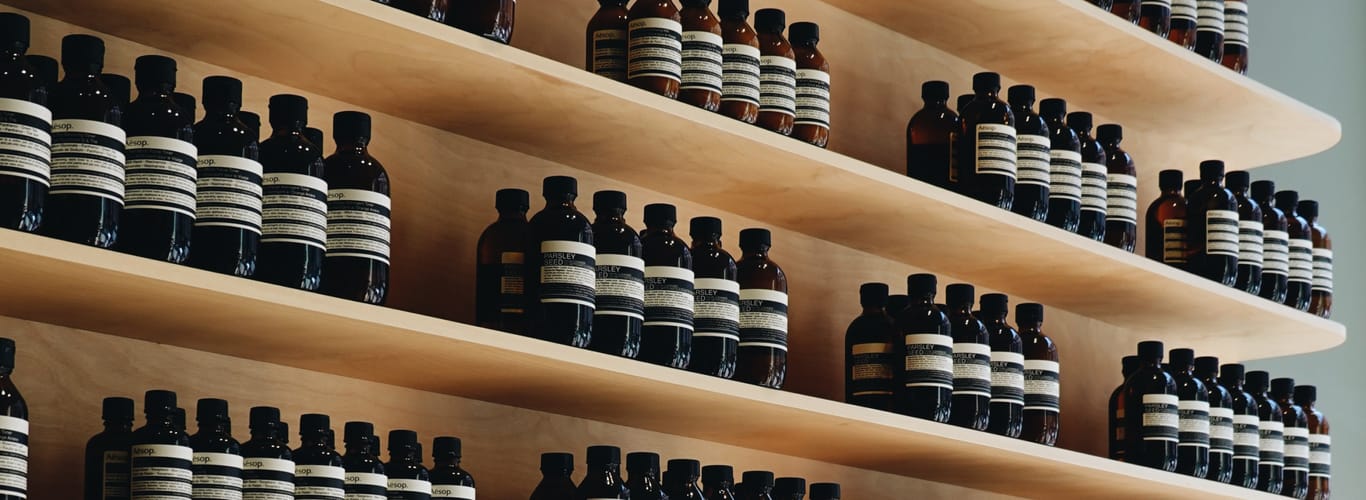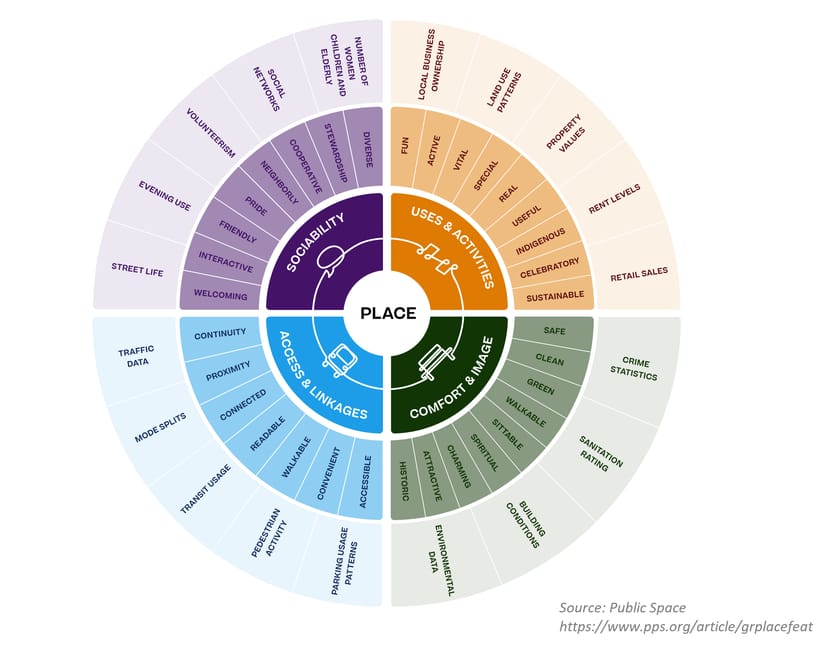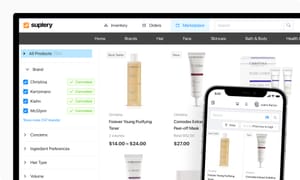How to open a beauty supply store in 2025: steps to success
Loading the Text to Speech Player...
Are you interested in starting a successful business in the beauty sector but are unsure of where to begin? Following the challenging Covid-19 years, the beauty market experienced a significant uptick in 2022, and by 2026, it is predicted to have reached a value of about $130 billion. So, saying that starting a beauty supply store can be profitable might even be an understatement.
However, proper planning and execution are required to ensure that you can keep up with thousands of competitors. This guide will show you how to open a beauty supply store and profit from it, taking you through each step of the process and providing relevant examples and ideas.
What is a beauty supply store?
A beauty supply store is a type of business that sells cosmetics and personal care items like hair, nail, and skincare products, makeup, and different accessories.
If that’s what you are planning to do, let's go through the exact process you will need to handle to start a beauty supply store as your own business.
Know what your clients really want!
Boost your salon clients with our 3 essential client feedback questionnaires PDF. Discover exactly what keeps clients happy — coming back. Download now to elevate your salon’s reputation!
Oh no! We couldn’t subscribe you ☹️
Done! We've sent a link to your Email 📨
How to open a beauty supply store step-by-step
1. First things first
Before you take any steps toward opening a beauty supply store, you should do a lot of research on the market. This means looking at the different niches and brands in the industry, figuring out who your target audience is, and figuring out how your competitors stack up. This will give you the information you need to make good decisions and get rid of many risks, like choosing the wrong positioning, pricing, or locations.
Here’s exactly what you will need to do:
- Define your audience and their needs. At the very beginning, you have to do high-level research and define who your clients will be and what they want or need — then think of possible ways to meet those needs.
For a beauty supply store, this means learning about your future customers and gathering all the necessary information, such as their ages, genders, income levels, cultures, personal habits, and preferences, in order to understand what beauty products they might be looking for.
For example, young professionals in an urban area might be looking for high-end and innovative beauty products, as well as men's grooming products. If the target audience is older individuals in rural areas, they might be more interested in traditional and familiar products with a focus on affordability and value.
- Choose your niche. After you have defined the existing variety of needs, you can choose one niche to focus on, such as organic products, high-end luxury brands, low-cost products, innovative brands, hair or nail products, color cosmetics, spa and wellness products, etc.
Choosing a niche will help you stand out, focus your efforts, compete more effectively, and increase your business’s profitability.
To make it work, your niche choice should be aligned with your choice of beauty brand, as well as your own policies and company values. For example, a store that specializes in luxury organic products will have different policies and values compared to another store that specializes in cheap and affordable products.
- Research the competition. Here, you will need to find your place in the niche among all the exciting competition.
To do that, you can check out existing beauty supply store websites and web reviews, visit their physical stores, or both. You can go even further and make purchases to see the whole process. All of this will help you figure out what other companies on the market do well and what they could do better, find untapped markets, and improve your strategy and positioning.
For example, you may find out that two stores in the area provide a wide variety of cheap and middle-priced products, but none focus on expensive luxury brands. If there’s a match with your existing target audience, it might be a nice potential niche to fill in.
- Choose a name. There are different approaches to naming, and the name of your store may be connected with beauty or not at all. Most importantly, the name you choose should be memorable and easy to say, and it should reflect what your store is all about.
For example, if you specialize in organic skin care products, something like "Organic Oasis" or “Naturals Beauty” would be a good fit. Likewise, “Hair Haven” or “Lush Locks” would go well for a store that offers a variety of hair care products.
After you have performed all the research, summarize your findings. Write down your niche, name, and insights after your target audience and competitive research.
2. Do you need a business plan?
It may appear that spending several months creating a large pile of documentation is necessary, but business planning is more than just endless pages of information. It’s more about thinking through your business idea and how it will be implemented. "How to open a beauty supply store" is a vital aspect of this process.
In fact, a business plan doesn't even have to be a lengthy white paper. It can be a simple presentation that answers all the core questions in concise sections, such as:
- Company overview – the general concept of your beauty supply store
- Industry analysis – key information about the beauty supply market in your chosen area that may influence your plans
- Customer analysis – a description of your target customers, along with their preferences, buying habits, budgets, etc., and your insights
- Competition analysis – data and insights on how to level the playing field in your chosen area
- Marketing plan – the description of where and how you are going to promote your beauty supply business, together with prices and possible discounts
- Business operations plan – the key day-to-day processes that enable you to run your business, including a growth timeline with milestones for the next few years
- Management team – the structure and required background for specialists who will run your beauty supply store
- Financial plan – details about your expected expenses and revenues
- Executive summary – a brief outline of all the major points from each section
As a result, you will have a comprehensive understanding of what your business is going to be about, how you will promote it, and how it is going to pay off. It will not only give you a better understanding of the next steps but also help you increase your chances of success.
3. Get the green light: obtain your license
Depending on the state where you are going to register your business, you may need licensing and permits before starting any professional activity, such as
- A general business license for operating your beauty store;
- A seller's permit to purchase beauty supplies wholesale and resell the products;
- A zoning permit to ensure that your business complies with location-related regulations.
You can go to your local SBA (Small Business Administration) office and the Department of Revenue in your state to find out at which agencies you need to apply for the permits and licenses.
4. The perfect spot: the key to a thriving beauty supply store
After you have your license, but before you finalize the documents, you should choose the location of your business.
The choice of location may totally make it or break it, and it’s not only about visibility (which can be partly fixed by pointers, signboards, or online geo-targeting). It’s also important to match your location with:
- your target audience — so that the right people will pass by;
- their intentions — so that when they typically pass by your store, they are not in a hurry, under stress, or affected by other adverse circumstances;
- the competition — ideally, so that there are no direct competitors too close;
- cost efficiency — so that the chosen location will be available for reasonable rent.
For example, if you specialize in luxury beauty products, you may want to open your store in an upscale neighborhood. If you offer budget-friendly supplies, look for a location in a more affordable area with high foot traffic.
This diagram made by Public Spaces gives an overview of all the important parameters for a location, and they are also pretty relevant for any other kind of business.
5. How to choose the right legal structure
Now that all the prep is done, let’s get closer to the point and figure out in more detail how to open up a beauty supply store.
Several types of legal structures are typically applicable to a beauty supply store business:
- Sole Proprietorship. Also called a sole trader, it's a type of company in which the business and its owner are the same entity. Many entrepreneurs find this option the easiest way to establish a small business, as it doesn't have to adhere to many government regulations, and you only pay an income tax. This does also mean that you shoulder all liability and responsibility concerning the business, and in case of business debt, your personal property may be at risk.
- Partnership. If two or more people want to own and operate the business together, they may establish a partnership. Partners are also personally responsible for business debts and obligations, and the overall procedures are very similar to a sole proprietorship. Still, you will also need to compose and sign a partnership agreement.
- Limited Liability Company (LLC). It’s an improved business structure that provides a certain level of protection to its owners and their private property. As an LLC, you and your possible partners aren’t held personally responsible for debt or liability. Also importantly, you may choose whether you want to be taxed as a partnership (where all profits and losses are reported on your personal tax returns) or as a corporation (which allows for the potential of lower overall tax liability). However, establishing an LLC requires more formalities than a sole proprietorship, such as obligatory registration of an EIN (Employer Identification Number), submitting the Certificate of Formation, and creating an operating agreement.
You can read about all the other types of business entities on the U.S. Small Business Administration website.
6. Legal backup: do you need a lawyer?
To actually register your beauty supply store business, you can do everything on your own or hire a lawyer. Let’s quickly go through both options with their main pros and cons:
- Registering a company by yourself is obviously cheaper and allows you to control the process fully. On the other hand, it will need more of your personal time, and even more importantly, mistakes in the registration process may turn into issues and financial losses.
For instance, lawyers are aware of the due dates for submitting different forms and finishing the registration process's steps. Without their assistance, you may run into additional fees and legal consequences. Another frequent occurrence is when a business registers under a name that is already protected by a trademark owned by another business, which may result in a legal dispute and possible fines.
If you co-own a business, it’s even more important to use professional legal support to avoid future conflicts that may turn into huge losses and negative experiences.
- Registering a company with a lawyer will give you peace of mind in knowing that all legal requirements and deadlines are met and no mistakes are going to lead you to fines or other consequences. It will also help you save a great deal of time and focus on other aspects of your business.
On the other hand, it’s not only much more expensive to hire a lawyer; often, it also means a certain level of dependence on the lawyer. Once the business is registered, you may still need a lawyer for legal advice and representation, which can be costly.
So, there’s no simple answer to whether you should choose a lawyer or not. It depends on your own legal expertise, the time you possess, and, of course, your available budget.
7. Steps to register your beauty supply business
Now, let's talk about how to start a beauty supply business officially. Here is the registration scheme, including both general and specific steps that depend on the exact business structure:
- Pick up the name, which will be unique and not protected by another trademark. You can check the availability of your chosen name in the trademark database on US Patent and Trademark Office website.
- Set up additional documentation:
- For Partnerships — Create and sign a partnership agreement, which outlines the rights and responsibilities of each partner.
- For LLCs — Submit articles of organization to the state, outlining the formation of the LLC, and draft an operating agreement with any business co-owners.
- Register with the Secretary of State — You can do it online on your state’s official website. After filling in the form and paying the fee, you will receive a file number, and your entity will be added to their online records.
- Register for taxes and get your Employer Identification Number (EIN) from the Internal Revenue Service (IRS).
After you finish these steps, your business will be officially registered and ready to go.
8. Money matters: secure your cash flow with a bank account
If you are a sole proprietorship and will work entirely on your own, you can use your Social Security number to open the bank account, but it will be harder to separate business and personal finances and track your business’s cash flow. For all other legal structures, it’s required to open a business bank account.
In general, opening a business account is not much different from opening a personal one. The only difference is that you might need to show more paperwork, like proof that your business was set up or licenses.
You can do it at any bank, but it’s always better to choose one with a convenient location, good services (online and mobile banking, merchant services, etc.), and low fees while avoiding other conditions that might cause a hassle, such as minimum deposit amounts or credit checks.
9. Get insured to safeguard your business
Business insurance is not always required by law, but it is highly recommended for any type of business, including a beauty supply store. It can protect the business and its owners from fines. There are several types of insurance policies you can apply for at beauty stores:
- Financial losses caused by accidents, lawsuits, and natural disasters, among other things.
- General liability insurance – protects your business in case of injuries and property damage
- Product liability – protects your business in case of claims that your beauty products have caused buyers harm
- Business property or business owner's policy – basic protection from on-premise customer injuries and property damage in case of catastrophic events or vandalism
- Worker's compensation – a state-regulated program that provides benefits to employees affected by job-related injuries and illnesses
When choosing a business insurance provider, consider their policies and coverage options, prices, claim processes, and customer reviews to make sure you will get what you expect rather than another legal issue.
10. Gearing up for success: purchase the essentials
After you are done with all the boring strategic and legal matters, it’s time to turn your attention to the various types of products and equipment you will need. So, what will you fill your beauty supply store with?
- Equipment. At a minimum, you will need shelving units, a cash register, lighting, a storage room, and a security system. Also, you may want to set up an employee rest area with chairs and a mini-kitchen or improve your shop with display cases, salon chairs, and other equipment to test and demonstrate your products.
- Decor. This one will depend on your chosen style concept. Additional lighting, mirrors, pictures, flooring, furniture, etc., etc. — it may include literally anything you can think of.
- Beauty supplies. Of course, it's high time you buy the supplies you're going to sell. You have chosen the major brands by now, but you may also want to improve your product line with accessories and other additions that may be bundled to increase the average check.
You are almost all set, but there are still a few more important things to set up.
11. Keep everything in order: establish an inventory management system
Even a small business may plunge into chaos if it tries to manage all of its supplies manually. If you don't have good inventory management, you'll have shortages, products that have gone bad, and all sorts of other problems.
You need to know all of your stock and quantities. You need to know if something is about to end or expire. Instead of manually checking every position, you should ideally receive automatic notifications when it's time to buy something. You need to order the required products as easily as possible.
This is where Suplery will come in handy to maneuver through all of these issues and tasks at once. Suplery is an online platform designed specifically for beauty businesses, where you can:
- Track all of your inventory and stock balances in real-time
- Prevent product shortages and excess stock
- Receive timely notifications
- Order products from the best beauty brands and suppliers
- Automate orders based on your usage history, existing stock, and safety stock amount
- Receive insights about your product usage and ordering
Suplery simplifies inventory list management and allows you to manage all of your inventory on a single easy-to-use platform.
12. Assemble your a-team: finding the best staff for your beauty supply shop
It’s finally time to hire the all-star team that will be the heart of your business.
First of all, think about the exact positions you will need to fill. You will probably need a store manager, sales associates, a cashier, an inventory specialist, and a customer service representative. In addition, you might want an accountant, beauty advisor, marketer, HR manager, or other professionals relevant to your specific store.
Calculate how many hours each of them will need to work to ensure there is no overload or free time that you will have to pay for. When you open, try to hire only the necessary staff.
A classic hiring process includes:
- Placing staff vacancy notices both online and offline
- Making a short list of the best candidates
- Handling interviews
- Signing contracts
It’s very useful to have written criteria for every position and make notes after every interview. In this way, you’ll be able to compare candidates objectively and not miss important details.
When you handle interviews, consider not only their experience and skills but also their certificates, customer service attitude, and cultural fit. Your team members should align with the concept of your beauty supply store and share your values.
13. Set the stage: decorating your beauty supply shop
Along with the hiring process, it’s also time to give the right spirit to your beauty supply store. Its interior and exterior should both align with your niche and target audience and help customers remember this exact store in a good way.
Here are some tips on how you can achieve all that:
- Create a concept or theme for your store that reflects your niche and target audience. For example, for a high-end beauty supply store that caters to a young and fashion-forward target audience, you may choose a minimalist design. For a beauty supply store that focuses on makeup and hair products with a more mature target audience, a more classic concept would be appropriate.
- Choose the right colors and materials that will complement your concept and resonate with your target audience. For a minimalistic concept, you may choose neutral colors with pops of metallic accents, sleek furnishings, and displays with a focus on clean lines and simplicity. For a more classic variant, warm colors, elegant furnishings, and framed artwork would be a good match.
- Think about the organization of the space and arrange products in a logical and easy-to-navigate manner. Consider using displays, shelving units, and signage to help customers find what they're looking for. Give your customers the opportunity to try or smell the products and learn about them from displays or printed materials.
- Add elements that enhance the shopping experience, such as a refreshment bar, a play area for children, or a lounge for customers to relax.
Let your customers feel comfortable in your space and find what they need easily.
14. What’s next? market your business!
Ideally, you should start thinking about marketing at the very first stage, when you perform your research. Who is your target audience? How can you appeal to their needs? How will you set your store apart from the competition? All of these inquiries have a direct bearing on marketing, so you ought to have given them some thought.
When you're almost ready to open up, you'll need a specific action plan so you can start acting right away and don't get off to a shaky start. Instead, you’ll attract a steady stream of customers from the very beginning.
Here’s how you can do it:
- Define your primary marketing goals. You’ll want to increase brand awareness, drive foot traffic, and/or boost online sales.
- Determine your budget. Be realistic and allocate resources accordingly.
- Choose your marketing channels. Focus on the most effective ways to attract your target audience. For example, social media platforms, such as Instagram, TikTok, and Snapchat, may work well to attract younger generations. Older generations may be more likely to respond to traditional marketing channels, such as television ads, direct mail, and local newspapers.
- Think about launch-boosting packages and offers. For example, you might offer a first-purchase discount or a set of bundles that are more beneficial to purchase than single items.
- Schedule your activities. Based on your chosen marketing channels, list the exact actions you will need to perform to take the promotions live, together with their timelines, budgets, and required human resources.
- Establish useful metrics. Measure the success of your marketing efforts in terms of website traffic, incoming calls, conversions, and engagement.
Additionally, it's a good idea to establish an opening event with a festive and welcoming atmosphere to help set the tone for your business and make customers feel welcome.
However, all of these efforts will be for nothing if you don't have a plan in place to effectively reach and attract potential customers. That's why it's important to start implementing a marketing strategy early on, even before your business is officially open.
How much does it cost to open a beauty supply store?
The exact cost of opening a beauty supply store will depend on a number of things, such as your location, the size of your store, the products you choose to sell, your marketing budget, the level of expertise of your employees, and so on.
As a rough estimate, you should plan on spending around $50,000 to $60,000 for the first three months of the operation. The total cost may reach $200,000 or more if you hire a lawyer and top-level staff, create a luxurious interior, etc.
This money will mostly be spent on registrations, rent, decorations, employee salaries, and the products you will be selling.
While this may seem like a significant investment upfront, a well-run beauty supply store has the potential to bring in more than this amount in annual profits. In other words, the effort and investment you put in at the beginning will be well worth it in the long run.
So, is it possible to open a beauty supply store with no money? Unfortunately, the answer is no, because you will at least need to buy the products you are going to resell and pay rent.
But don't worry! There are a few ways you can try to cut costs. For example:
- choose a lower-cost location;
- consider buying used equipment;
- minimize marketing expenses;
- hire part-time or freelance help.
If it’s still over your budget, try negotiating trade credit with your suppliers or using installment payments to ease the burden on your cash flow.
If those options don't work, you could look into financing options, like bank loans or government grants, to help you get the necessary funds for your inventory.
Don't give up! With a little effort and creativity, you might be able to make it happen.
Stay ahead in beauty business
Feast on the latest marketing techniques and business tips. Elevate your game with every read!
Unveil secretsConclusion
If you take the time to get ready, opening a beauty supply store can be a profitable and fun way to start a business.
So, how to open a beauty supply store? First and foremost, you need to find out who your target audience is and where your store should be. You'll also need to get all the licenses and fill out any paperwork that's needed. Once you have everything in place, it's time to start ordering products for your store.
But where do you even begin? With so many beauty suppliers out there, it can be overwhelming to try and find the best ones. That's where Suplery comes in. They make it easy to connect with top beauty suppliers, so you can get the products you need to stock your store and start selling.
Remember, starting a beauty supply store takes time and effort, but with the right preparation and resources, you can turn your dream into reality. Get started today and take the first step towards building a successful business.
 The latest articles and industry insights delivered to your inbox
The latest articles and industry insights delivered to your inbox
Subscribe to receive a monthly digest of our most valuable resources like blog posts, whitepapers, and guides.
Oh no! We couldn’t subscribe you ☹️
Done! You've subscribed 💛
Unsubscribe anytime. Your data is stored for business-to-business communication purposes. See our Privacy policy.
Frequently asked questions
What is the step-by-step process of opening a beauty supply store?
Opening a beauty supply store includes the following steps:
- Conduct market research
- Create a business plan
- Obtain required licenses
- Choose a location
- Register your business
- Open a bank account
- Get business insurance
- Purchase inventory
- Establish an inventory management system
- Hire staff
- Decorate your beauty supply store
- Set up and launch the marketing plan
- Open doors to customers
How much does it cost to start a beauty supply store?
The cost of starting a beauty supply store can range from $50,000 to $200,000 or more, depending on factors such as the location, size of the store, inventory, and marketing expenses. Costs can vary widely based on the specific business model, so it's important to do thorough research and budget planning before starting a beauty supply store.
Last updated on Apr 01, 2025
“What Changed” in this article? Everything. It's packed with the latest findings, the ripest data, and a fresh analysis you won't find anywhere else.
A subject-matter expert wrote the content, and reliable, official sources support it. Recent research has been incorporated to maintain relevancy and accuracy.
Please share this post
Unlock FREE bonus material!
Get your hands on "Spa business plan". Subscribe to our newsletter and receive a link to download it straight to your inbox.
Oh no! We couldn’t subscribe you ☹️
Done! We've sent a link to your Email 📨
Trusted by the best in the beauty industry.
Transform your beauty business with Suplery!
Already enjoying our expert tips? Take the next step and join Suplery to revolutionize your business operations.
Huge range of professional products
One-click checkout after first order
Automated predictive orders
Seamless inventory management
From words to action
Start working with Suplery and explore all the tools and services you need to expand your business
Get started with Suplery24/7 Support
Secure payments
Designed by industry’s experts





